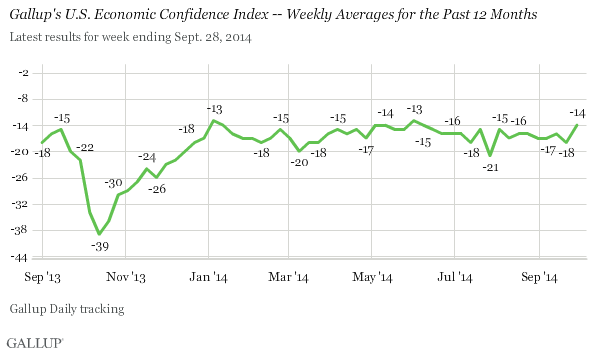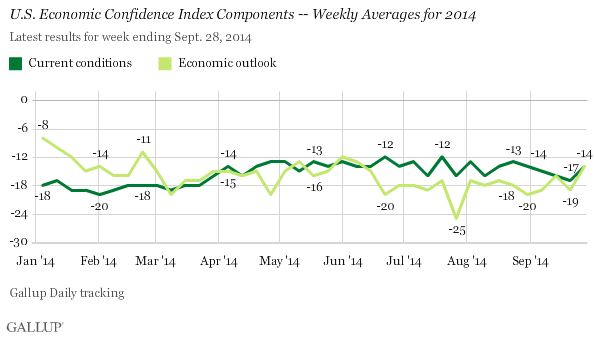WASHINGTON, D.C. -- Gallup's U.S. Economic Confidence Index rose four points to -14 for the week ending Sept. 28. This increase comes after a two-point drop to -18 the week prior and is the largest weekly increase since early August. Americans' economic confidence is now as positive as it has been since early June.

Broadly speaking, confidence has been remarkably flat in 2014, staying firmly in negative territory within a narrow range of -13 to -21, with last week's uptick coming after several weeks in the middle of that range. In the last year, economic confidence has dropped to as low as -39 during the partial government shutdown in October. Congress recently passed a spending bill to avoid another shutdown this year.
Gallup's Economic Confidence index is the average of two components: Americans' views of current economic conditions and whether they say the economy is getting better or worse. Both increased last week from the week before. In the U.S., 20% say the economy is "excellent" or "good," while 34% say it is "poor." This results in a current conditions score of -14, up from -17 the previous week.
The economic outlook score increased by five points, from -19 to -14. This was the result of 40% of Americans saying the economy was getting better while 54% said it was getting worse. The current conditions component last reached -14 in late August and has been as high as -12 several times in 2014.

Implications
While Americans are still not confident in the economy, the increase in confidence last week reverses the slight dip in confidence the week before. The stock market had a turbulent week last week, but finished on a positive note. And the Commerce Department on Friday reported that the U.S. gross domestic product increased by an encouraging 4.6%, in its final estimate for the second quarter.
Last week's four-point rise in economic confidence was greater than most of the weekly changes in 2014. But that will have little significance if confidence falls right back, as it has tended to do this year. The last time the weekly average in economic confidence changed at least this much, a six-point increase in early August , it quickly retreated the following week. While Americans still do not appear ready to have great faith in the economy, they are far more confident than during the 2008-2009 recession and its immediate aftermath.
Gallup.com reports results from these indexes in daily, weekly, and monthly averages and in Gallup.com stories. Complete trend data are always available to view and export in the following charts:
Daily: Employment, Economic Confidence and Job Creation, Consumer Spending
Weekly: Employment, Economic Confidence, Job Creation, Consumer Spending
Read more about Gallup's economic measures.
View our economic release schedule.
Survey Methods
Results for this Gallup poll are based on telephone interviews conducted Sept. 22-28, 2014, on the Gallup Daily tracking survey, with a random sample of 3,539 adults, aged 18 and older, living in all 50 U.S. states and the District of Columbia.
For results based on the total sample of national adults, the margin of sampling error is ±2 percentage points at the 95% confidence level.
Interviews are conducted with respondents on landline telephones and cellular phones, with interviews conducted in Spanish for respondents who are primarily Spanish-speaking. Each sample of national adults includes a minimum quota of 50% cellphone respondents and 50% landline respondents, with additional minimum quotas by time zone within region. Landline and cellular telephone numbers are selected using random-digit-dial methods. Landline respondents are chosen at random within each household on the basis of which member had the most recent birthday.
Samples are weighted to correct for unequal selection probability, nonresponse, and double coverage of landline and cell users in the two sampling frames. They are also weighted to match the national demographics of gender, age, race, Hispanic ethnicity, education, region, population density, and phone status (cellphone only/landline only/both, and cellphone mostly). Demographic weighting targets are based on the most recent Current Population Survey figures for the aged 18 and older U.S. population. Phone status targets are based on the most recent National Health Interview Survey. Population density targets are based on the most recent U.S. census. All reported margins of sampling error include the computed design effects for weighting.
In addition to sampling error, question wording and practical difficulties in conducting surveys can introduce error or bias into the findings of public opinion polls.
For more details on Gallup's polling methodology, visit www.gallup.com.
